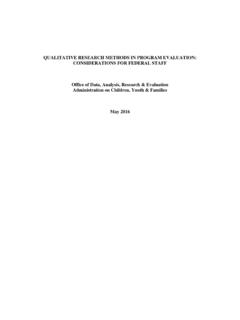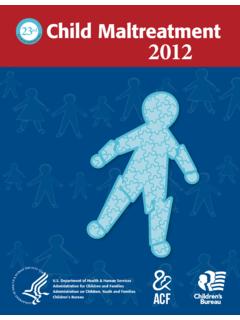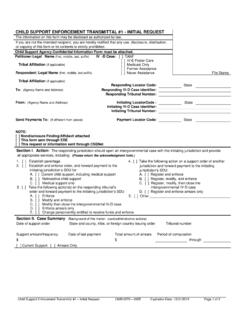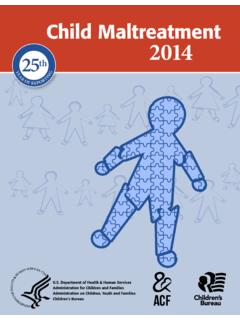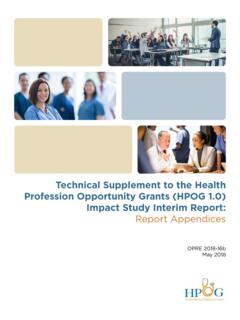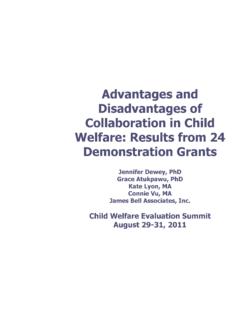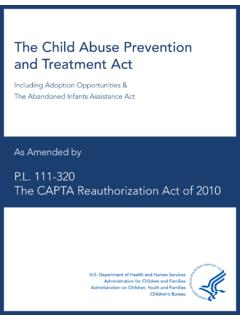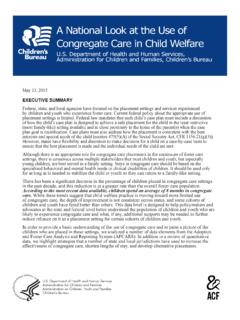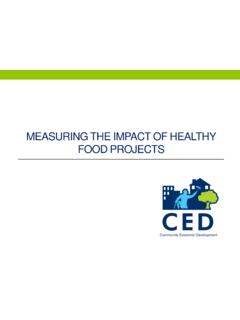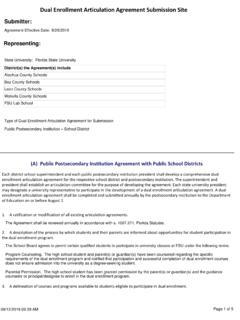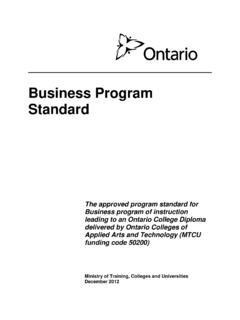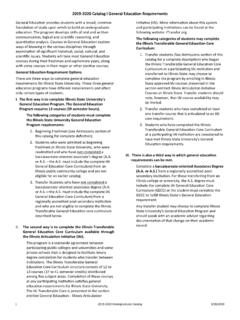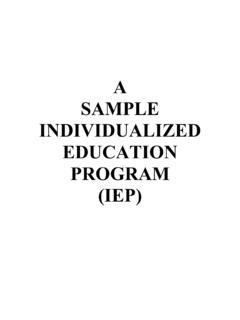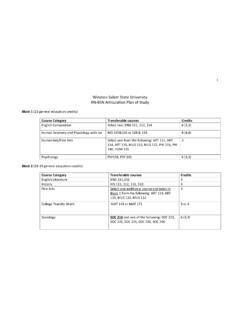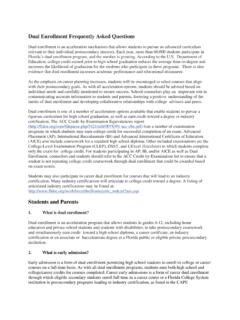Transcription of ACF
1 1 ACF Administration for Children and Families DEPARTMENT OF HEALTH AND HUMAN SERVICES Administration on Children, Youth and Families 1. Log No: ACYF-CB-PI-18-09 2. Issuance Date: November 30, 2018 3. Originating Office: Children's Bureau 4. Key Words: Family First Prevention Services Act, State Title IV-E Prevention and Family Services and programs , Title IV-E Prevention Program PROGRAM INSTRUCTION TO: State Agencies Administering or Supervising the Administration of Titles IV-B and IV-E of the Social Security Act SUBJECT: State Requirements for Electing Title IV-E Prevention and Family Services and Programs1 LEGAL AND RELATED REFERENCES: Titles IV-B and IV-E of the Social Security Act (the Act), as amended by Public Law ( ) 115-123 Family First Prevention Services Act, enacted February 9, 2018 and 115-271, the Substance Use Disorder Prevention that Promotes Opioid Recovery and Treatment for Patients and Communities Act (SUPPORT for Patients and Communities Act), enacted October 24, 2018 PURPOSE: To instruct state title IV-E agencies on the title IV-E prevention program requirements INFORMATION: The Family First Prevention Services Act (FFPSA) authorized new optional title IV-E funding for time-limited (one year) prevention services for mental health/substance abuse and in-home parent skill-based programs for.
2 1) a child who is a candidate for foster care (as defined in section 475(13) of the Act), 2) pregnant/parenting foster youth, and 3) the parents/kin caregivers of those children and youth (sections 471(e), 474(a)(6), and 475(13) of the Act). 1 Hereafter in this document, the title IV-E prevention and family services and programs are referred to as the title IV-E prevention program. The prevention and family services provided under the title IV-E program are referred to as title IV-E prevention services. 2 Instructions for the Title IV-E Prevention Program: This Program Instruction (PI) provides instructions on the requirements state title IV-E agencies must meet when electing the title IV-E prevention program as described below.
3 We provide instructions for Indian tribes, tribal organization, or tribal consortia operating an approved title IV-E program in ACYF-CB-PI-18-10. Organization of the Program Instruction Foreword Section A. Requirements for providing title IV-E prevention programs 1. Title IV-E prevention program components 2. State five-year title IV-E prevention program plan Section B. Child and family eligibility for the title IV-E prevention program 1. Prevention plan for the child 2. Candidates for foster care 3. Age Section C. Federal financial participation (FFP) Section D. Financial reporting Section E. Maintenance of effort (MOE) Section F. Title IV-E prevention program reporting Section G. Title IV-E plan requirements Section H. Non-impact on eligibility for other assistance Section I.
4 Payer of last resort Section J. Instruction Attachments A. Children s Bureau Regional Program Managers B. State title IV-E prevention program five-year plan pre-print Attachment I. State title IV-E prevention program reporting assurance Attachment II. State request for waiver of evaluation requirement for a well-supported practice Attachment III. State assurance of trauma-informed service-delivery Attachment IV. State annual MOE report C. HHS practice criteria for title IV-E prevention services and programs and initial list of services and programs undergoing HHS practice criteria evaluation Foreword The creation of the title IV-E prevention program is an unprecedented step in recognizing the importance of working with children and families to prevent the need for foster care placement and the trauma of unnecessary parent-child separation.
5 The title IV-E prevention program is part of a much broader vision of strengthening families by preventing child maltreatment, unnecessary removal of children from their families, and homelessness among youth. It provides an opportunity for states to dramatically re-think how they serve children and families. It creates 3 an impetus to focus attention on prevention and strengthening families as our primary goals, rather than foster care placement as our main intervention. The Children s Bureau strongly encourages all states to take this opportunity to not only use the title IV-E prevention program to fund these important services, but also to envision and advance a vastly improved way of serving children and families, one that focuses on strengthening their protective and nurturing capacities instead of separating them.
6 A. Requirements for providing the title IV-E prevention program 1. Title IV-E prevention program components Categories of allowable title IV-E prevention services: State title IV-E agencies may claim reimbursement for mental health and substance abuse prevention and treatment services provided by qualified clinicians, and in-home parent skill-based programs that include parenting skills training, parent education, and individual and family counseling that have been rated and approved by the Title IV-E Prevention Services Clearinghouse and are identified in the state s five-year title IV-E prevention program plan (section 471(e)(1) of the Act). We interpret the term in-home broadly, in that it does not necessarily refer to the location in which the services are provided.
7 It could mean, for example, that the child is continuing to live in the home of a parent or relative caretaker during the time the state is providing the services. The needs of the child, parent, or caregiver for the services must be directly related to the safety, permanence, or wellbeing of the child or to preventing the child from entering foster care. We are not further defining qualified clinician as used to describe a provider of mental health and substance abuse prevention and treatment services identified in the plan (section 471(e)(1)(A) of the Act). Trauma-informed approach to service delivery: Title IV-E prevention services must be provided under an organizational structure and treatment framework that involves understanding, recognizing, and responding to the effects of all types of trauma and in accordance with recognized principles of a trauma-informed approach and trauma-specific interventions to address trauma s consequences and facilitate healing (section 471(e)(4)(B) of the Act).
8 We are not further defining what a trauma-informed approach to service delivery means. Practice criteria for prevention services: Title IV-E prevention services must be rated as promising, supported, or well-supported in accordance with HHS criteria and be approved by HHS (section 471(e)(4)(C) of the Act) as part of the Title IV-E Prevention Services Clearinghouse (section 476(d)(2) of the Act). The initial practice criteria are provided in Attachment C. The Title IV-E Prevention Services Clearinghouse is in the process of reviewing and rating services for HHS approval. Attachment C includes the first list of the services that the Clearinghouse will review and rate under the HHS initial practice criteria. We will provide additional information regarding rated and approved services, and the selection of additional services for review in future issuances.
9 4 At least 50 percent of the amounts expended by the state for a fiscal year (FY) for the title IV-E prevention program must be for services that meet the well-supported practice criteria (section 474(a)(6)(A)(ii) of the Act). Time-limited services: The state may provide title IV-E prevention services as specified in the child s prevention plan for up to 12 months beginning on the date the state identifies the child as either a candidate for foster care or a pregnant or parenting foster youth in need of those services (sections 471(e)(2)(A) and (B) of the Act) (see section below). The state may claim title IV-E reimbursement for prevention services until the last day of the 12th month if services were provided for the entire 12-month period, or if services are provided for less than the entire 12-month period, the end of the month in which the child s title IV-E prevention services ended.
10 A state may provide title IV-E prevention services to or on behalf of the same child for additional 12-month periods, including for contiguous 12-month periods. In order to claim title IV-E for each additional 12-month period, the state must determine and document in the child s prevention plan that the otherwise eligible candidate for foster care or pregnant/parenting youth meets the requirements in section 471(e)(4)(A) of the Act on a case-by-case basis. 2. State five-year title IV-E prevention program plan The state title IV-E agency electing to provide the title IV-E prevention program must submit a five-year title IV-E prevention program plan (five-year plan) that meets the statutory requirements and may use the state title IV-E prevention program five-year plan pre-print found in Attachment B (section 471(e)(5) of the Act).
